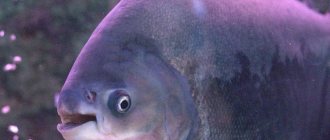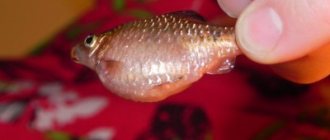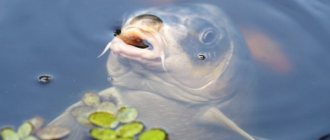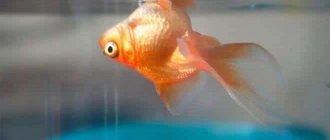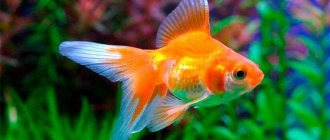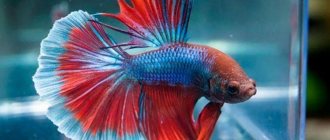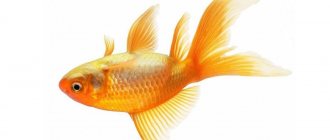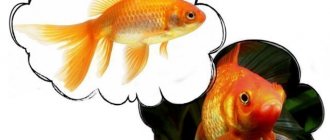Ascites (dropsy) is an accumulation of fluid in the abdominal cavity. This disease is always noticeable: the fish’s belly becomes evenly swollen. However, abdominal distension also accompanies other conditions: tapeworm infestation or pregnancy/spawn maturation. Since effective treatment of dropsy is possible only in the early stages, and with advanced disease the fish dies from hemorrhage, it is important to diagnose the disease correctly.
Disease – “abdominal dropsy”
This disease has some distinctive features. The main one is ruffled scales, which makes the fish resemble a pine cone. The fish also experiences rapid breathing, weakness and dull color. The disease occurs as a result of viral or bacterial infections, and also occurs with hexamitosis disease. Old individuals, weakened fish or obese fish are susceptible to dropsy. Unfavorable living conditions and frequent stress also contribute to the infection of aquarium fish. In order to prevent dropsy, it is advisable to keep the fish in optimal conditions for them, moderately feed them with high-quality and varied food, but keep new fish in quarantine.
Diseases of fish with weakened immune systems
Dropsy in fish is a group of symptoms caused by a bacterial infection found in all aquariums. Any fish can be exposed to the bacteria that causes dropsy, but healthy fish rarely become victims of the disease. Fish are susceptible only when their immune system is weakened by some stress factor. If all the fish in an aquarium are stressed, it is likely that the entire aquarium will become contaminated. Even one or two fish may become ill, especially when the owner takes immediate action to prevent the spread of bacteria.
Overfeeding
Some fish swallow large pieces of food, which can then remain in their bodies for up to several days, bloating their bellies and causing indigestion. To prevent this from happening, break up your food into smaller pieces.
Intemperance in nutrition leads to obesity in fish, as a result of which their bellies again become swollen.
What to do: unfortunately, nothing can be done here; in 99.9% of cases everything ends in death.
During life, such fish often additionally suffer from abdominal dropsy and cannot reproduce due to obesity in the ovaries and testes. And there can only be one piece of advice - do not overfeed.
Reason 1. Appearance of caviar
This is perhaps the most pleasant and harmless reason for a fish to bloat its abdomen. Caviar forms and develops in the female's abdomen, due to which the abdomen can become quite impressive.
What to do: be patient and wait for spawning, properly caring for the expectant mother.
Viviparous fish are capable of producing fairly large and fully viable fry. The process of bearing eggs is called pregnancy.
Inflammation of the gastrointestinal tract
If the fish is confirmed to have inflammation of the stomach and intestines, this indicates a lack of varied food. Symptoms of this disease in waterfowl pets:
- Weakness.
- Darkening of the color of the fins and body.
- Lethargy.
- Loss of balance.
- Change in excrement.
- Swelling of the abdomen with loss of appetite.
What to do:
To prevent this disease, it is worth reducing the fish’s consumption of dry food. It is recommended to wash them, soak them, disinfect bloodworms and tubifex worms, and diversify the diet.
Treatment of fish with saline solution
Treatment is carried out as follows:
- We transplant the cockerels into a separate container.
- Take pure salt and dissolve it in warm water (2 tablespoons of sodium chloride per 10 dm3).
- Turn on the aerator for 20 minutes.
- We launch the fish (if they lie sideways, you need to dilute the mixture).
Often this medicine for betta fish is enough to cure any infectious diseases.
It is important that there will be no benefit from one time: such treatment should be carried out in courses over a period of two weeks to a month. In a favorable situation, treatment of betta fish with chloramphenicol brings instant results.
Vibriosis
Its causative agent is the bacterium vibrio. The disease affects fish that live in salt or brackish water. However, bacteria can also enter freshwater household ponds with seafood feed.
All fish that have poor living conditions and weakened immunity are at risk.
The disease can be acute or chronic and is manifested by lethargy, apathy, rapid breathing, desire for privacy, subcutaneous hemorrhage, changes in the skin of the fin on the back, tumors, ulcers, and so on, including bloating of the abdomen.
Vibriosis is often confused with other infectious diseases, and the truth can only be revealed by laboratory research.
What to do: quarantine and treat with antibiotics, nitrofurans and sulfonamides, adding them to the water, as well as chloramphenicol (to food). All drugs are purchased at a pet store, and the dosages and treatment times are indicated in the instructions for them. Prevention consists of careful care, disinfection of water and feed, control of nitrates, nitrites and ammonia in the water.
Vibrosis
This disease occurs due to infection of the fish by the bacterium Vibrio.
Most often, the disease affects individuals living in salty or slightly salty water, with a weakened immune system, as well as fish living in poor conditions. The bacterium penetrates into the home pond along with seafood complementary foods. The disease manifests itself chronically or acutely, and is expressed by the following symptoms:
- apathy;
- change in the shade of the dorsal fin;
- subcutaneous bleeding;
- rapid breathing;
- ulcers;
- desire to be alone;
- tumors;
- bloating of the abdominal cavity.
Many diseases in fish have such symptoms, so in order to clarify the correct diagnosis, you need to go to a veterinary hospital and have your pet examined.
What to do:
- When establishing this diagnosis, it will be necessary to isolate the sick fish from other cohabitants, and drip nitrofurans, antibiotics, and sulfonamides into the water for medicinal purposes. These drugs are sold in a veterinary pharmacy or store, and the daily dosage of medications can be found in the attached instructions.
- For preventive purposes, you will need: regular pet care, disinfection of complementary foods and liquids, control of chemicals in water: nitrites, nitrates, ammonia and others.
Bloating Malawi
Cichlids from water bodies in East Africa are susceptible to this disease. It was first discovered in fish from Lake Malawi. The symptoms are similar to dropsy, but it is a completely different disease. Little has been researched.
It can be recognized by lethargy, loss of appetite, shortness of breath or increased breathing. At first the fish stays near the surface of the water, but within a day its belly swells greatly and it can no longer swim, it lies on the bottom. Death occurs within a maximum of three days.
The causes of the disease are considered to be poor quality water, the presence of sodium chloride in water for a long time, and a diet consisting only of dry food and mammalian meat.
What to do: exclude the causes of the disease. You can try to treat with broad-spectrum antibiotics, but their effectiveness has not been proven.
Fish most often die after suffering, so they are most often euthanized.
Ichthyophthiriasis (semolina)
Have you noticed nodules or white bubbles on the body of the fish, reminiscent of lumps of semolina? Your pet is unhappy with the temperature of the water or the dirt, so she has contracted an infection caused by the ciliate ichthyophthirius. The signals are:
- Lack of appetite.
- Slow breathing;
- Impaired coordination of movements.
- Decreased activity.
- Weight loss.
In addition to bicillin-5 and trypaflavin, it is worth treating your betta fish in a salt bath.
Attention! Don’t think that just adding table salt will make the bacteria disappear. The recommended proportions must be carefully observed: non-compliance with the technology and excessive saturation of the solution lead to the death of the cockerel.
Advice for aquarium owners!
- Slow swelling of the fish's abdomen can occur due to obesity, proliferation of tapeworms or tumor-like neoplasms.
- Rapid bloating if the health of aquatic pets is affected by bacteria or poor aquarium conditions.
After the death of an individual inside the aquarium, fermentation of its abdominal cavity occurs, as a result of which it increases in size, but this is not the reason for the death of the pet. To minimize the risk of bloating in the fish’s abdomen, you will need to create the most favorable conditions for them, proper nutrition, and add only healthy new roommates. In this case, the home aquarium will delight the eyes of its owners for years.
LEPIDORTHIS: SYMPTOMS, TREATMENT, DRUGS.
BRANCHIOMYCOSIS: TREATMENT, SYMPTOMS, DESCRIPTION.
THE TWO MOST COMMON DISEASES OF FRESHWATER AQUARIUM FISH
DISEASES OF AQUARIUM CATFISH: semolina, white spots
Reason 11. Gonadal cysts
Most often, this disease affects species that easily collect eggs in an aquarium, but at the same time require special conditions for spawning - characins, labyrinths and cyprinids.
The cause of the cyst is the separate keeping of males and females, unfinished eggs, pathologies during the opening of the genital opening, monotonous feeding and high temperatures.
Externally, cystic fish look as if they are ready to spawn, so the tumor is not detected immediately. Sometimes a signal of its occurrence can be swollen eyes and dropsy. A cyst in an animal’s body, as it grows, gradually puts pressure on the internal organs, and its rupture leads to instant death.
In the early stages, the cyst can be gently squeezed out by gently massaging the abdominal part towards the genital opening. If the disease is advanced, then it is better to use euthanasia on the fish.
And in conclusion, we add that slow-moving bloating can be due to tapeworms, obesity or a tumor. And fast-flowing - due to pathogenic bacteria or poor living conditions. Take care of your fish, don’t leave their nutrition and health to chance.
Basic methods of prevention
Most of these diseases can lead to the death of the betta fish, so it is necessary to follow certain rules for caring for the aquarium and its inhabitants.
Let's highlight a few basic recommendations:
- Wash your hands with antiseptic or regular soap before any manipulation with your pets, as well as after working with them.
- Monitor the quality of the feed, preventing it from becoming expired. It is very important not to overfeed the fish, and also to give food at approximately the same time.
- Maintain optimal water temperature, avoiding hypothermia.
- Take into account the compatibility of betta fish with other types of aquarium inhabitants. Avoid overcrowding.
- Any decor and soil must be disinfected before being placed in the aquarium.
- Periodically use vitamin complexes to maintain the health of your pets.
- Fish purchased from a pet store must undergo mandatory quarantine. They need to be kept in a separate tank for 1-3 months, monitoring their condition.
We have looked at the main diseases of betta fish and possible ways to treat them, but it is important to understand that this process requires certain knowledge and practice.
This type of aquarium fish has a fairly strong immune system, so it actively fights the disease, but if no action is taken, the individual will die.
Columnaria
If the cockerel is swollen near the gills, most likely there is an “oral fungus” that appears due to overcrowding, high concentration of organic matter, and untimely feeding.
The disease can be detected by the following signs:
- Lethargy.
- The desire to hide in a secluded place.
- Dark coating on the gills.
- Mouth damage.
- The appearance of cloudy fluid in the eyes.
Treatment of fungus in betta fish begins with the use of complex remedies, the use of disinfectants, and baths with phenoxyethane. Some people suggest adding methylene blue or Merbromin to promote faster healing.
Have you noticed that one or more pets are not feeling well? Now you know what diseases a cockerel can catch, and you can easily select the appropriate medications.
Unable to diagnose the disease? There are many photos on the Internet that help you establish and select effective treatment during consultation with specialists.
Exophthalmia (bulging eyes)
If you notice a change such as bulging eyes in betta fish, it is a viral infection that is treated with Epsom salt (magnesium sulfate) and Ammonia-minus treatment.
The surface of the eye becomes cloudy, wrapped in a white film, the eyes can pop out of their sockets: in the most severe case, the cockerel will lose its organs of vision and die.
If you notice that the cockerel fish has become sad and its eyes have become white, take action (a favorable outcome depends on the timely detection of the disease). Replace the water, reduce food intake - if the source is improper conditions, then the swelling of the eyes will go away quickly.
These measures did not help, other infected people began to appear with a gray coating on their bodies and difficulty breathing? Place them in a plastic container, use ointments and antibiotics.


